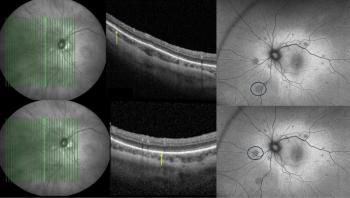
Delving into ancillary testing frequency based on the IRIS registry
Dr Ted Leng discusses his presentation, “Variations in Vitreoretinal Physician Utilization of Ancillary Testing: An IRIS Registry Analysis” during Retina Specialty Day at AAO 2021.
At the 2021 American Academy of Ophthalmology annual meeting, Dr Ted Leng presented his talk entitled “Variations in Vitreoretinal Physician Utilization of Ancillary Testing: An IRIS Registry Analysis” during Retina Specialty Day. The IRIS Registry Analysis considered how many ancillary tests were ordered on a per patient basis, accounting for a variety of factors to identify patterns.
Video transcript
Dr Ted Leng: This is a really exciting study that we conducted using the American Academy of Ophthalmology’s IRIS registry, given just a large amount of data that's in there. And as a retinal physician, we are super reliant on ancillary testing in our everyday practices to see, you know, which patients have retinal disease and how we're managing them.
So what we wanted to do in this study was to look at the utilization of ancillary tests by retinal physicians in the United States on retinal patients.
To go into some more detail, this was a three-year study, where we looked at retinal physicians from January 2018 to December 2020. And look at the amount of OCTs, fundus photographs and fluorescein angiograms they were performing. And then we normalized that data and looked at how physicians in different regions throughout the United States were using these tests, whether certain payers like Medicare or non-Medicare were utilizing these tests, and then also different practice settings, such as academic medical centres versus non-academic medical centres.
What we found was actually quite interesting. Once we did normalize the data, we did see that physicians in the Midwest region—and we use the four regions of the US Census Bureau—so the Midwestern states actually were performing more OCTs on a per patient basis than physicians in other regions. Medicare patients were getting more OCTS on a per patient basis per year than non-Medicare patients. And lastly, patients cared for in a non-academic medical centre, were getting more OCTs on a per patient basis than that not.
So I think, while those results in and of themselves are interesting, we then delve deeper into trying to ask why we saw these differences in practice patterns amongst retinal physicians. And one of the things that we looked into was the volume of wet macular degeneration patients as a kind of benchmark to see if that affected the use of OCT-A, for example.
So what we did was we asked, does a physician who sees more wet AMD patients per year use more OCT or less OCT than someone who doesn't do as many wet macular degeneration patients.
And what we did find was that retinal doctors who saw more wet AMD patients also ordered more OCTs in general.
And what we did with that information, is we went back and did a reanalysis of the data, our findings, and saw that yes, indeed, Midwestern physicians also see more wet AMD patients than non-Midwestern physicians. And that could help to explain why more OCTs are being performed in the Midwest on a per patient basis.
And similarly, in the Medicare population, there are more new wet AMD patients. And in the non-academic medical centre setting, there are more wet AMD patients that are new. So that's why it could help to explain why we are performing as a specialty more OCTs and other ancillary tests in those regions. And in those pair types in this practice settings.
What are the implications for the larger community? I just think it's really good to know, you know, how we're practicing medicine, what the patterns of utilization of our ancillary testing is, so that we can then better inform how to make our practices more efficient, how to better deliver care to the patients, and maybe even identify underserved populations.
You know, one thing we did see was that in the Medicaid population, there was less OCT-A utilization. And so we do need to delve deeper into maybe an explanation as to why that is, but they could be an indication that that populations being under cared for and underserved. And maybe, you know, we need to be ordering more tests to, to better manage those patients. So I think that's one of the potential takeaways from this presentation.
Newsletter
Get the essential updates shaping the future of pharma manufacturing and compliance—subscribe today to Pharmaceutical Technology and never miss a breakthrough.













































